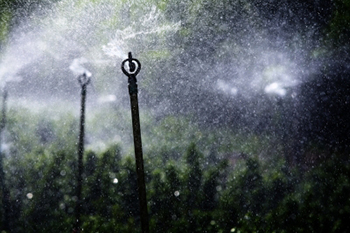 AUSTIN, Texas — With minimal rain, commercial water consumers are prompted to implement innovative ways to conserve water, but it can be difficult to know how to start the process without a water expert on staff.
AUSTIN, Texas — With minimal rain, commercial water consumers are prompted to implement innovative ways to conserve water, but it can be difficult to know how to start the process without a water expert on staff.
Fortunately, there are many ways building managers, property owners and facility managers can use readily available technology to effectively and efficiently manage water. Better yet, they can do it in a way that maintains vibrant properties while saving on utility costs.
Property managers want to ensure the aesthetic appearance of their facility is as inviting on the outside as it is on the inside, which requires a solid landscaping strategy with the use of water to maintain greenery. We see myriad reasons why water is so important for properties, so how can we maintain a building’s exterior, save water and reduce irrigation costs?
Assess the Situation
As the saying goes, “You can’t manage what you can’t measure.” A variety of online resources are available that estimate how much water is required for a landscape given its location and characteristics; comparing that to a water bill will provide a good starting point for understanding baseline water use and areas for improvement. Irrigation system inspections are a good way to quickly identify if water is being wasted due to issues like broken sprinkler heads or water running off into the street. While monitoring and control technologies can achieve significant savings, a properly functioning irrigation system is a necessary first step.
Anyone can begin the process by tracking monthly consumption on water bills — a surprisingly obvious, yet overlooked, resource. Armed simply with a spreadsheet of monthly use, property managers can begin to identify trends and anomalies. Yet, a single number representing a month’s consumption is often insufficient to make meaningful efficiency gains. When does water use spike during the day? Is there consumption in the middle of the night? With real-time data and good analysis and visualization tools, data begin to paint a much better picture of water-use patterns and allow users to begin making improvements.
Irrigate Intelligently
Irrigation controllers are ubiquitous on campuses, but technology advancements have significantly improved the ability to save water and manage complex sites. One of the biggest improvements for increasing watering efficiencies is in the incorporation of weather data into irrigation schedules so sprinklers don’t run before, during or after rainstorms. In addition, connecting irrigation hardware to the Internet provides visibility into irrigation history and system performance without setting foot onto the property itself.
While irrigation management is a mature industry, indoor water management technology is a new advancement. Utility-based smart meters have become more popular but rarely provide detailed water use data to end-users. Fortunately, the recent availability of monitoring and communication technologies can deliver powerful information to property managers’ fingertips in real time.
Make Savings Sustainable
While smart controllers determine irrigation requirements, landscapes are heterogeneous and constantly in flux. Irrigation zones can be replanted or moved, wires can be cut and pipes can break, among other issues. Maintaining a water-efficient property means staying on top of these issues so that landscapes stay healthy and water isn’t wasted. Measuring and analyzing water consumption in tandem with smart controls and system alerts allows users to consistently minimize water waste and maximize savings over time. The good news is that today’s real-time technologies can lead to significant savings without sacrificing landscape health, even if water restrictions are in effect.
While monitoring technologies immediately provides value through identification of large anomalies, water waste is often smaller and more gradual. Because of this, water data are much more valuable when consistently tracked over time to allow historical trends to emerge. Water-use data also become actionable when compared to other properties, and this benchmarking lets portfolio managers knowledgeably prioritize efficiency efforts at properties where the best ROI exists.
Gillan Taddune is the CEO of Banyan Water.

